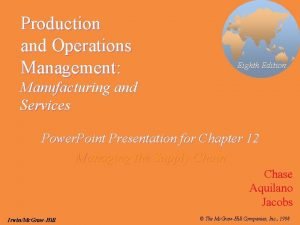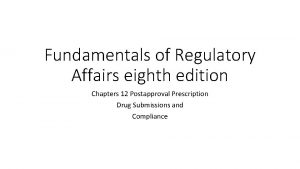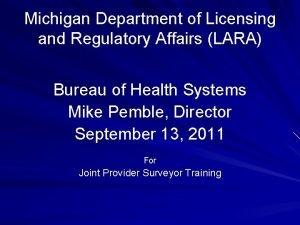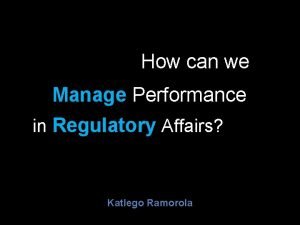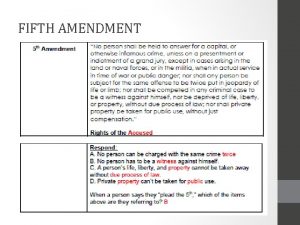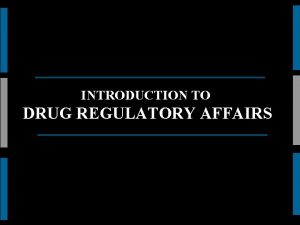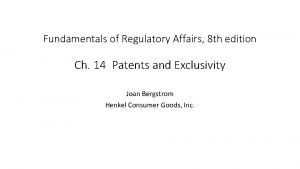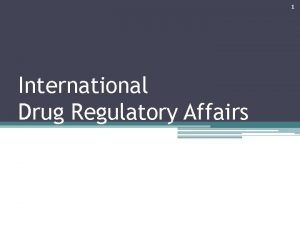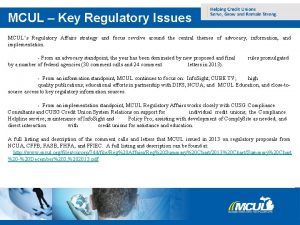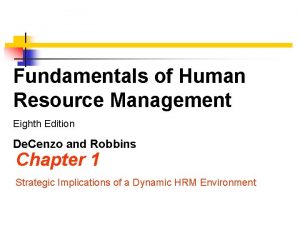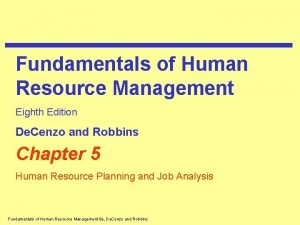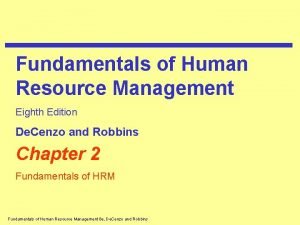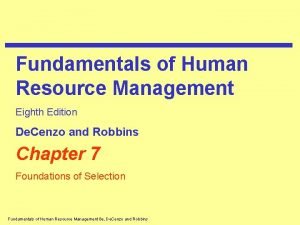Fundamentals of Regulatory Affairs eighth edition Chapters 12




















- Slides: 20

Fundamentals of Regulatory Affairs eighth edition Chapters 12 Postapproval Prescription Drug Submissions and Compliance

Chapter focus • c. GMP manufacturing regulations, • Postmarketing adverse drug experience reporting requirements • Postapproval maintenance of regulatory applications/files (e. g. , NDAs, ANDAs and Drug Master Files (DMFs)), including postapproval changes and postapproval requirements of commercial prescription drug manufacturing

c. GMPS • 21 CFR 210 and 211 • Non compliance = adulteration • The CGMP regulations for drugs establish minimum requirements for manufacturing, personnel, equipment, control of product, containers/closures, facilities, packaging, holding and distribution procedures and the associated process controls • Ensure that drugs are safe and that requirements are met for quality, identity, strength and purity

API GMPs • Active pharmaceutical ingredients (APIs) are subject to the adulteration provisions of Section 501(a)(2)(B) of the FD&C Act, which requires all drugs to be manufactured in conformance with CGMPs • Doesn’t distinguish between API and Drug Product • No regulations specific to API or Drug Component c. GMPs • FDA applies concepts of 21 CFR 210 and 211 to APIs • Good Manufacturing Practice Guidance for Active Pharmaceutical Ingredients Q 7 A. ICH Q 7 (as it now is commonly called) represents FDA’s current thinking on CGMPs for APIs.

Quality Systems Approach to Pharmaceutical Current Good Manufacturing Practice Regulations • 2006 FDA guidance • Build quality into product • Four major sections of the quality systems model include responsibilities resources manufacturing operations evaluation activities management • Facilitate the development of a quality system, harmonize CGMP regulations, reduce the number of prior-approval type regulatory submissions, implementing Quality by Design (Qb. D)

FDA’s Compliance Program Manual • Instructions to FDA personnel for conducting inspections • Six interrelated systems are the quality system and the five manufacturing systems (facilities and equipment, materials, production, packaging and labeling and laboratory controls • Systems-based inspection compliance program ensures the applicant must have the ability to assess whether each of the systems is in a state of control

Guidance for Industry: Pharmaceutical Quality System ICH Q 10 • Describes one comprehensive model for an effective pharmaceutical quality system that is based on International Organization for Standardization (ISO) quality concepts • Complements ICH Pharmaceutical Development Q 8 and Quality Risk Management Q 9 • The content of the guidance that exceeds current regional GMP requirements is optional • Intent is to strengthen the link between pharmaceutical development and manufacturing activities

Post Approval Changes • Discussed in 21 CFR 314. 71, including: • Only the sponsor, or its designated agent, can supplement the application • Only information related to the proposed change(s) is required to be submitted • Requirements for archival, review and field copiesare the same as for original application • Require reporting CMC changes to the drug substance and drug product that may affect the marketed product’s identity, strength, quality, purity or potency • Typographical and spelling errors and changes in formatting to standard operating procedures or batch records need not be submitted

Three types of changes Type of Change Postapproval Reporting Category Implementation Examples Major Change Prior Approval The change has Supplement (PAS) substantial potential to cause an adverse effect on a drug product’s identity, strength, quality, purity or potency Approval of the supplement is required prior to distribution of product manufactured using the proposed change(s) Establishing a new regulatory analytical procedure including designation of an alternative analytical procedure as a regulatory procedure • A change in qualitative or quantitative formulation Moderate Changes Being The change has moderate Effected in 30 Days potential to cause an Supplement (CBE-30) adverse effect on a drug product’s identity, strength, quality, purity or potency. Product manufactured using the proposed change(s) may be distributed 30 days after submission of the supplement if the sponsor is not informed otherwise by FDA Changes in the size or shape of a container for a sterile drug substance • Relaxing an acceptance criterion or deleting a test to comply with an official compendium that is consistent with FDA statutory and regulatory requirements

Three Types of Changes, Continued Type of Change Postapproval Reporting Category Implementation Examples Moderate Changes Being The change has moderate Effected Supplement potential to cause an (CBE or CBE-0) adverse effect on a drug product’s identity, strength, quality, purity or potency. Manufacturer can distribute product manufactured using the proposed change(s) immediately following submission of the supplement A change in or addition or deletion of a desiccant • Adding or strengthening a contraindication, warning, precaution or adverse reaction on the product Labeling Minor Change Annual Report The change has minimal potential to cause an adverse effect on the drug product’s identity, strength, quality, purity or potency. Product manufactured using the proposed change(s) can be distributed prior to reporting the change; the change is reported in the next Annual Report A move to a different manufacturing site for secondary packaging (manufacturing) • Extension of an expiration date based on full shelf-life data when the data were obtained in accordance with an approved stability protocol

Post Approval Guidances • SUPAC IR, MR, SS • Comparability protocols – may get approval to reduce reporting category one level • PAS becomes a CBE 30, etc • Check the guidance for good examples

Adverse Drug Experiences The sponsor is required to review ADE information obtained from all potential sources (foreign and domestic), including: • marketing experience (e. g. , ADE reports from • healthcare providers, patients, competitors, etc. ) • scientific literature (peer-reviewed and • non-peer-reviewed) • unpublished reports • postmarketing clinical investigations • postmarketing epidemiological/surveillance studies

Reporting requirements • Postmarketing 15 -Day Alert Reports—A sponsor shall submit any foreign or domestic ADE that is both serious and unexpected (defined below), whether or not it is considered to be drug related, within 15 days following receipt of the information. If additional information is received after an initial report is submitted, the new information also shall be submitted within 15 days of receipt as follow-up reports or as requested by FDA. • Periodic Adverse Drug Experience Reports (PADER)—For the first three years following a drug’s approval, a sponsor shall submit a PADER on a quarterly basis. Unless otherwise requested by FDA, after three years, the sponsor shall submit the PADER at annual intervals.

ADE reports • a narrative summary and analysis of the report’s information, including all ADE information obtained during the reporting period • analysis of the 15 -Day Alert Reports submitted during the reporting interval • any Form FDA 3500 A (Med. Watch) for an ADE that was not submitted as a 15 -Day Alert Report • any actions taken during the reporting period due to ADEs (e. g. , labeling changes or additional studies initiated)

PSUR vs PADER • Sponsors with a product that is approved in the US and at least one other ICH region have successfully negotiated with the FDA to manage some of the periodic ADE reporting requirements more efficiently by use of the Periodic Safety Update Report (PSUR) or the emerging Periodic Benefit-Risk Evaluation Report (PBRER)

ADE reporting • Know each requirement: • “unexpected” ADE is defined as an ADE not listed in the drug product’s current labeling • “serious” ADE is defined as an experience that results in: • • • death a life-threatening event in-patient hospitalization or prolongation of existing hospitalization a persistent or significant disability/incapacity a congenital anomaly/birth defect

Medical Terminology • Med. Watch forms • Council for International Organizations of Medical Sciences (CIOMS) • MEDRA • FDA Adverse Event Reporting System (FAERS) • FDA initiative to rapidly collect, analyze and disseminate drug safety information. This initiative is highlighted by FDA’s Guidance: Drug Safety Information—FDA’s Communication to the Public (March 2007). • REMS Risk Evaluation and Mitigation Strategies

Other Reporting • Field Reports • Annual Reports content review • Advertising and labeling • Orange Book Submissions for patent exclusivity • Complaints – could be an ADE

Recalls • Class I Recall—when there is a reasonable probability that the use of or exposure to a suspected product will cause serious adverse health consequences or death • Class II Recall—when the use of or exposure to a suspected product may cause temporary or medically reversible adverse health consequences, or where the probability of serious adverse health consequences is remote • Class III Recall—when use of or exposure to a suspected product is not likely to cause adverse health consequences, but the product violates FDA labeling or manufacturing laws

DMFs • Type II—chemistry, manufacture and control information for drug substances, intermediates and materials used in their preparation or similar information for drug products • Type III—component, composition, controls for release and intended uses of packaging materials • Type IV—excipients, colorants, flavors, essences or materials used in their preparation • Type V—FDA-accepted reference information
 David g myers psychology 8th edition
David g myers psychology 8th edition Operations management eighth edition
Operations management eighth edition Psychology eighth edition david g myers
Psychology eighth edition david g myers Post approval regulatory affairs
Post approval regulatory affairs Lara renew nursing license
Lara renew nursing license Kpi regulatory affairs
Kpi regulatory affairs Seventh amendment meaning
Seventh amendment meaning Quarter inch fraction
Quarter inch fraction Seven eighths crown
Seven eighths crown The fifth, sixth, seventh, and eighth amendments protect *
The fifth, sixth, seventh, and eighth amendments protect * Eighth amendment excessive bail
Eighth amendment excessive bail Anagram of eighth
Anagram of eighth Eighth commandment catholic
Eighth commandment catholic Eighth amendment excessive bail
Eighth amendment excessive bail Eighth letter of the alphabet
Eighth letter of the alphabet Inner planets matching
Inner planets matching Taj mahal wonder of the world
Taj mahal wonder of the world Fundamentals of organizational communication 9th edition
Fundamentals of organizational communication 9th edition The fundamentals of political science research 2nd edition
The fundamentals of political science research 2nd edition Electronics fundamentals a systems approach
Electronics fundamentals a systems approach Fundamentals of information systems
Fundamentals of information systems

